Balsfjord to Dividalen
In which we leave big-city Tromsø for an empty national park, and discover some lovely coastal farming country and lefse.
Leaving town
Norwegians are hothouse flowers. Or so you might think, if you saw contemporary Norwegian architecture outside of its very harsh context.

Many homes and apartments from the last 40-50 years seem to have given up the tall, square, center-hearth simplicity. In exchange, they got the ability to harvest as much sunlight as possible during the long winter months. Even the homes and hytter that preserve the traditional shapes do large panes of glass on their south faces. I probably would too, if I lived here.
The frequency of rain and wind here can make it hard to motivate sometimes. We spent an extra day in Tromsø in part to wait out a bad forecast, “slept in” until 8, had a last lovely breafkast with Ira. We talked shop about the collapse of the educational system in Greece, and pondered the fact that it’s much easier to see the worst of your country from inside. We showered (again!) and finally got on our bikes fearing the worst.

We biked over Tromsø’s north bridge into some normal-crusty-american-town-looking suburb. They were testing the local alarm system to make sure it would work if Putin decided he wanted another front for his war.

We had done the morning’s short ride with things strapped all higgledy-piggledy to our bicycles, accommodating a box of stuff we planned to ship out as soon as we could find a post office. In a minor miracle worked through Heidi’s attentiveness, even the poorly attached bear can made the trip without falling. Aurora was working at the Post Norge counter in the grocery store where we resupplied on gummy candy and brown cheese. She was the most helpful ever. I was nervous that navigating international shipping and customs would be horribly expensive and complex. Just $50 and a few minutes later, a big box of our things was bound for the USA.
Trampolines in Norway
H and I have gotten a lot of mileage out of trampoline jokes on this trip.

“Do you think people who live this far north buy their kids trampolines because they know they’ll never find friends within 50 kilometers?”
“Does Norway have a social program supporting the underprivileged children who don’t have trampolines yet?”
“Free trampoline with purchase of two or more waterfalls”
They’re ubiquitous. We see nearly as many trampolines as we do Norwegian flags, and the pennant-style flags are everywhere after Norway’s recent national day.

The magic begins again
And then we blinked and the suburbs were gone, replaced by magical Norwegian countryside.

Reindeer dressed in grey and brown fed in the tall grass and horsetail, and the first rhododendron and cloudberry flowers appeared in the heather.

A british traveler we met at the grocery had argued that the only bad part of Norway was the weather, but the promised rain mostly held. When it didn’t, my new neon-yellow rain pants were just amazing. Armored in these things, I can take on the world. We had a quick lunch on a rock ledge by the road, and zipped through the 2.7km Rya-tunnel. (“The best tunnel in the world, if there is such a thing!” - H)

The country here on Balsfjord is agricultural, and so, so sweet. The Kommune’s crest is a plow, and the character of the place shows in the long meadows, soft round hills, and in reflection on the flat blue of the fjord below.

We passed the prettiest of the stone-ramped barns we’ve seen. This design is common, though the barns are usually shorter and the ramps much shorter, with about two meters between the stone and the building bridged with wood. These bridges often serve as roofs for closed sheds or cellars, allowing for a little more storage and a little less stone between the hillside and the building.
Toves tradisjonsmat
Plunked down in the middle of this green and lovely country is a small cafe and farm. Tove’s Tradisjonsmat caught our attention for its name (traditional food), and was a perfect stop on our road. Their pastries were very good, and though we didn’t try them, they also serve and sell local seafood and meat. Tove’s annual plant sale was running on the day we stopped by, so she was out in the garden and we were helped by Anna and Evelyn, a neighbor and the baker respectively.

The baker, that is, of everything but the lefse. Lefse, a light pancakey pastry folded around a layer of butter and sugar and sometimes brunost, is something of a rite of passage here, it seems. Despite spending a couple of years baking with Tove, the mentor still hasn’t been willing to pass the Lefse torch. We hope that some day, Evelyn, the time for your Lefse apprenticeship will come. For now, though, we’ll content ourselves with your delicious kanelsnurr.

Lefse is new for us, and we got to try both mørlefse and gammeldagslefse. There is at least one more common type - knekklefse, or something like that - cooked on the griddle with maybe an extra layer of batter? More fun than the new food, though, was the fact that Tove and Evelyn both have an interest in wild edibles and herbs. We learned that young birch leaves make a mildly sweet tea. It was great to talk foraging a bit with someone who knows the area better than we do.
Life in the water
Rolling south from Toves Traditionsmat is rolling along a quiet coast. There are farms and homes along the way, but little traffic. The water, as usual, is right there at your side - just across the meadow or lawn. It, too, is quiet - I wonder often whether the water’s always flat calm deep in the fjords, or whether this is just the face it’s shown us so far.

The tide pools here hold the most exciting signs of life we’ve seen in the water so far. A few small mussels (blåskjell), barnacles, and a bunch of worms enthusiastically eating and pooping under the sand. VERY exciting!
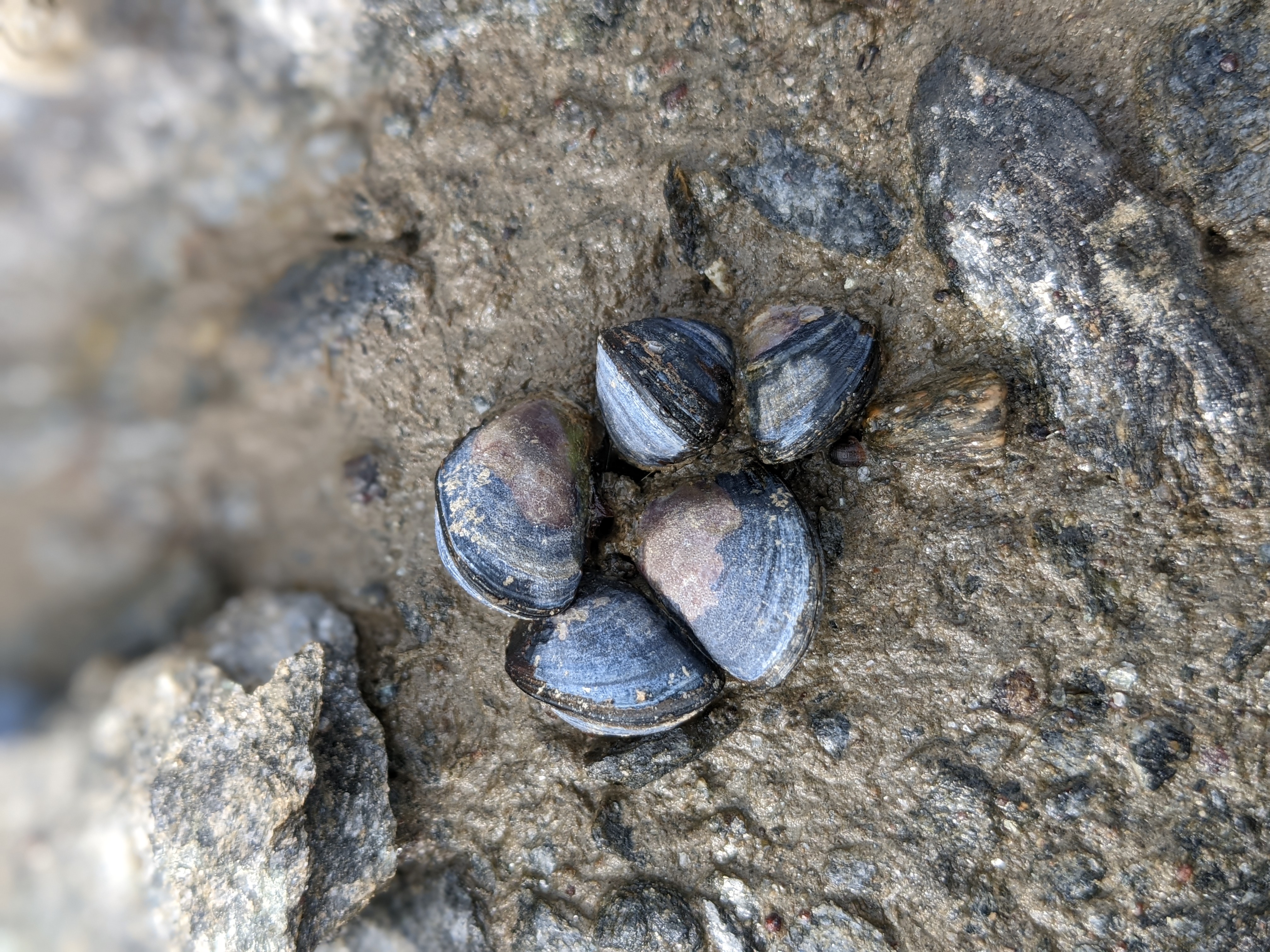
Finding camp sites
Lovely as it was, the day went on and on and on.

I don’t think we rode particularly far or particularly slowly, we just took our time forever.
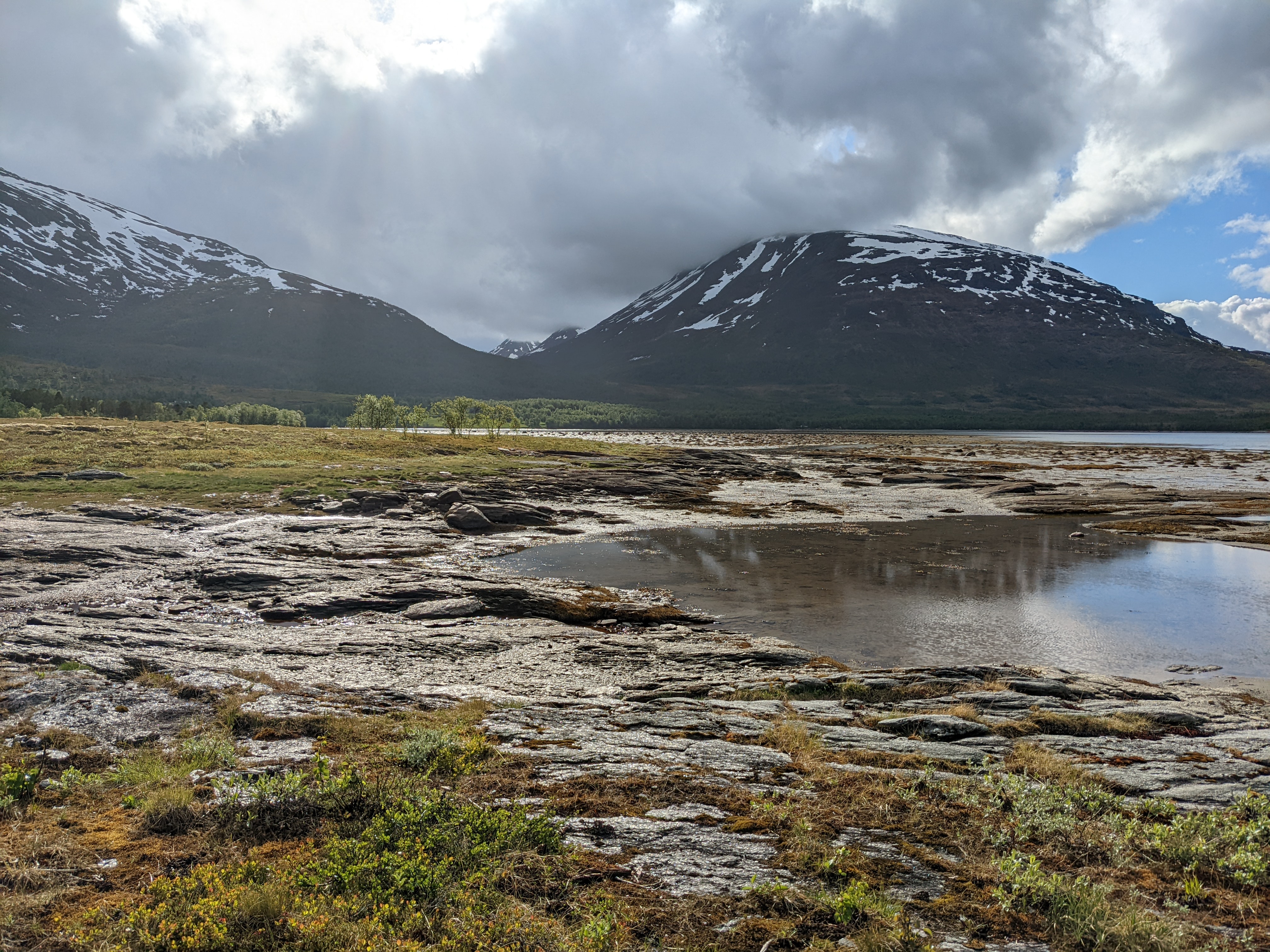
Around dinner time, we looked off a beautiful birch bench between two widely spaced homes. Plenty of room between the trees, dead flat, and a great view. We just didn’t feel like we’d put in our miles yet, I guess. Camp sites got pretty hard to find after that one, though, and everyone gets tired eventually.
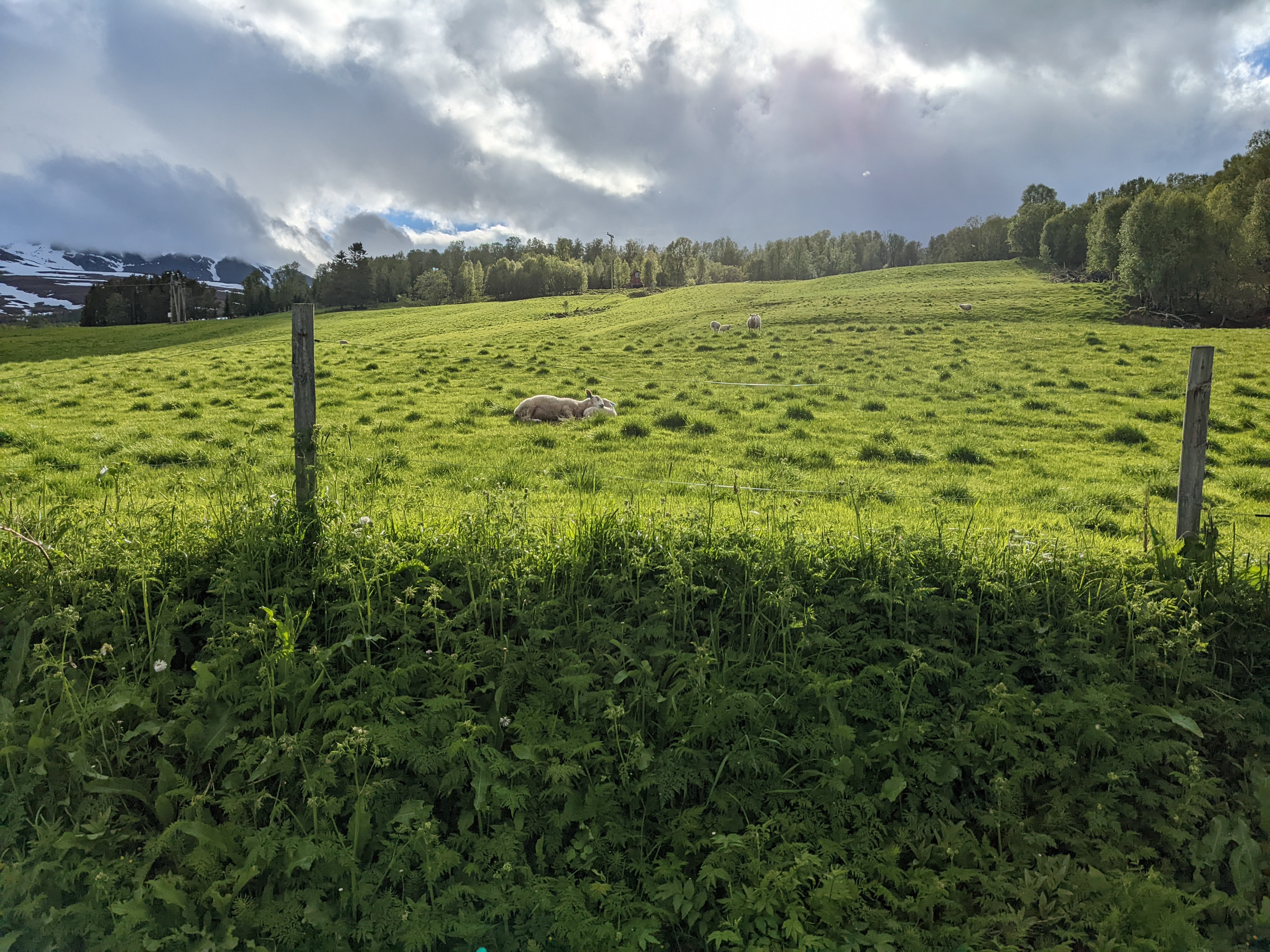
Norway’s Allemansretten protects our ability to travel, forage, and sleep respectfully on private property, but it has its limits. Sometimes camp sites are hard to find because the homes are too densely spaced to camp legally. Camping on cultivated land is (quite reasonably) not protected, but I’m not sure where the line is drawn there - is a hay-meadow cultivated? How about wildflower pasture? What if it has a fence, but there are openings instead of gates?

Sometimes camping is hard because there are livestock on the land. No one benefits from bothering the animals, of course. Most often, though, camping is hard because the landscape here in Norway is difficult to sleep on. Most places are either steep or soggy. There is wetland everywhere, and we’ve slept on dry-ish flat spots in marshy areas because that is all we’ve got. Sometimes we think we see a spot, but getting the bicycles there is problematic, and sometimes the birches and willows grow too thick along the road for us to see anything.

Even with the Allemansretten, it can be a challenge. Without it, travelling in this way legally would be very difficult, as I imagine it is in many parts of the US.

These factors pushed us up and over one more pass than we had hoped to ride, and at 20:00 we were still looking for a flat, dry spot to camp for the night. At 21:00, we found a picnic table and made dinner, because sometimes that’s all you’ve got.

At almost 22:00, while the rice was rehydrating, I went bushwhacking in search of a spot. My mind was tired, and I was a little desparate to find a place that would work. H doesn’t do super well with late nights, and the search for a camp site had been going on for hours now. After charging around in the woods like a maniac for a while, I got a bit lost. Coast roads make for great navigational handrails, though, and I was back to the picnic table shortly with directions to another lovely sleeping swamp. It was a bit of a trek to get the bikes there, but the gravel ride out in the morning was great!

The clown crew heads inland
The next morning dawned soggy and cool but brought with it an auspicious realization. Like a couple of workwear fashion plates, we had inadvertently dressed ourselves as perfect opposites with maroon and neon yellow jackets, pants, and even gloves. Ahhh, love.

We biked past snowy mountains.
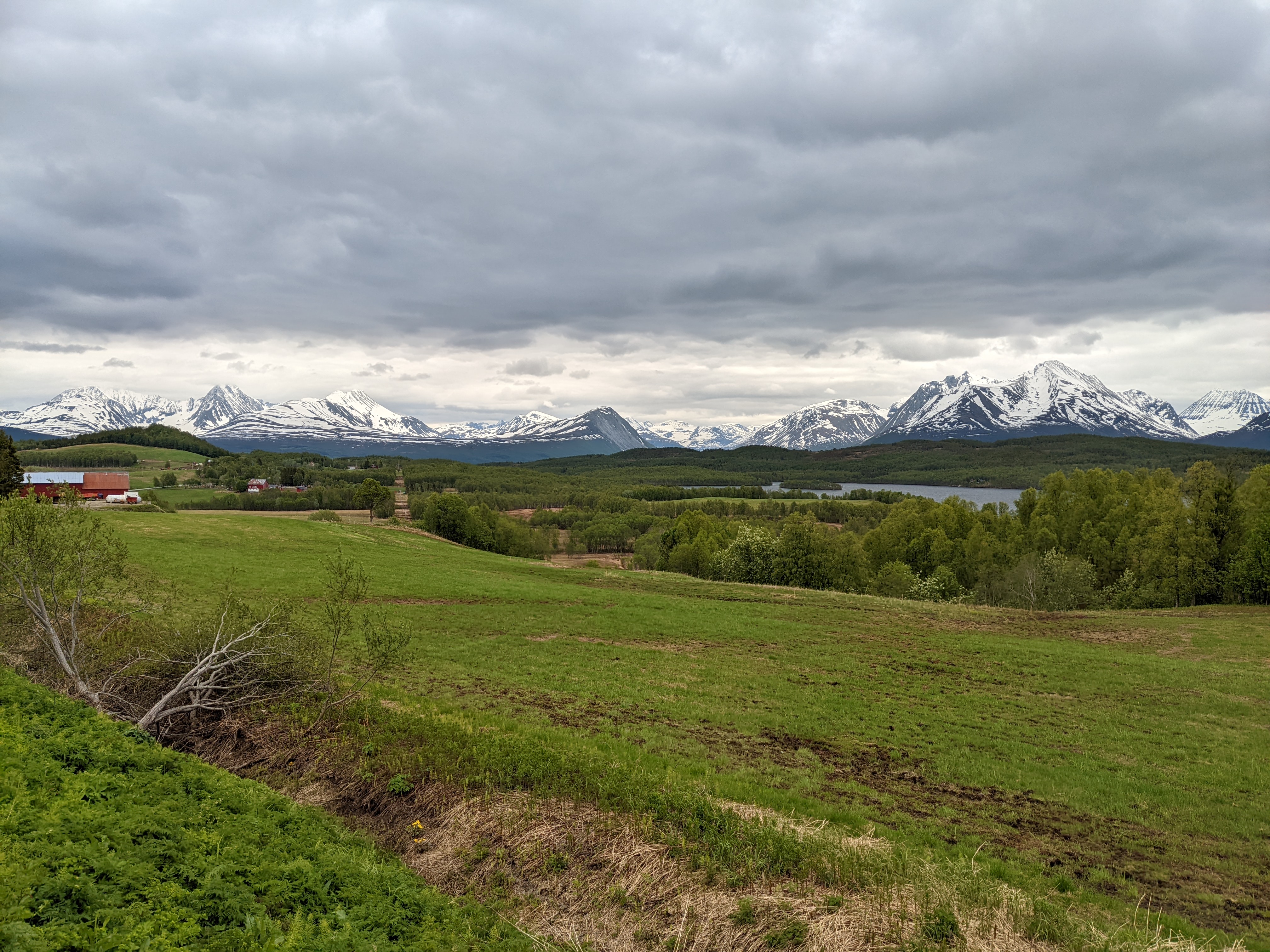
We biked past coastal farm land.
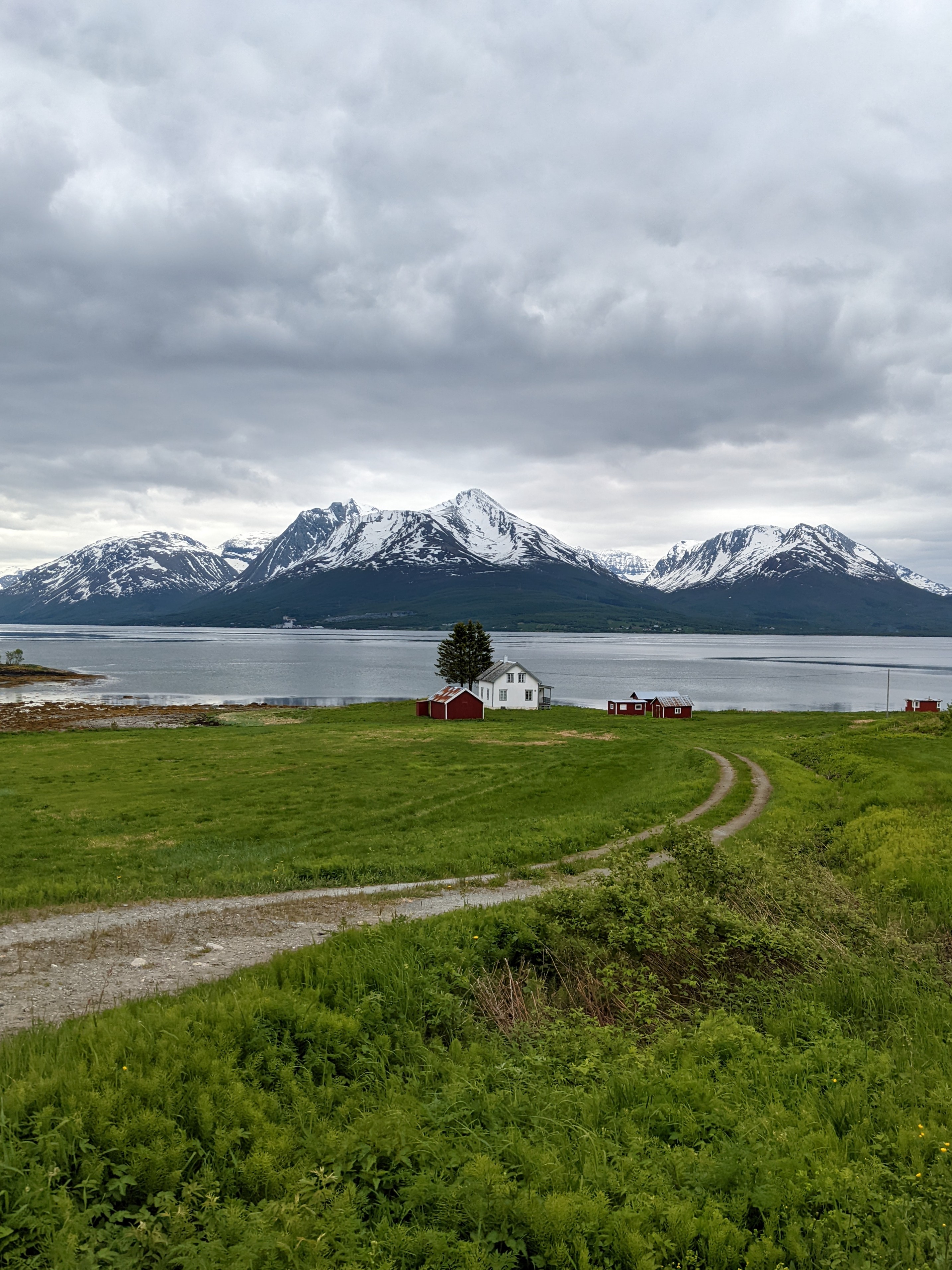
We stopped at a museum that was closed, and ate lunch there anyway.

We bought groceries in Storsteinnes, and talked to a man with schizophrenia outside the grocery. His family was so old in his part of the country that the glacier above their town shared his family’s name. It was a small town, though, and he had found much better care here in Storsteinnes. He was candid about his experience, as many of the people we’ve spoken to have been about things we don’t discuss much in the US. Mental health, menstruation, abortion, toilets and their use - all on the table for frank discussion with near-strangers. It’s refreshing how little shame there seems to be about being human here.

We bought weird (and delicious) snack food.

I spent an hour or two at the library, doing onboarding and relocation paperwork for the job I’ll begin in the fall. Hege, one of the librarians, welcomed us warmly. We talked a little, and learned that she had made most of the very fun, and funny art in the small space. It’s an older building, they have a small budget, and sea monsters are way cooler than holey old wallpaper.

We rode on past a beautiful little lake with yet another rainbow hanging over it. (Norway gives you little rewards with almost all of its challenges.) At one end of the lake, I met an ice cream man, who told me I should go and relax in the open hexagonal shelter there. It was labeled Vassenden Habakkuk, and like the many smaller hexagonal buildings we’ve wondered about on private property, it was crowned with a metal stovepipe chimney. This one, though, is a public space, free for use by the community or passers-by. A group of old friends had been grilling and spending the afternoon there, and though we didn’t stop long to talk, they were lots of fun.

On the road again
From the lake, we climbed up towards the E6 again. The road is busier here, by far, than it was out in eastern Finnmark. As with the E8 south of Tromsø, the cars move fast and the riding can be a bit gripping.

Roadside souvenier shops seem to be a universal presence by the highways of the road, and this one was the best I’ve ever visited. The building is a large, four-peaked tent, drawing on the Sami teepee tradition. It smells lightly of smoke from the wood hearth near the entrance. There are tchochkes and graphic tees and walls of plastic junk, but there are so many beautiful things too.
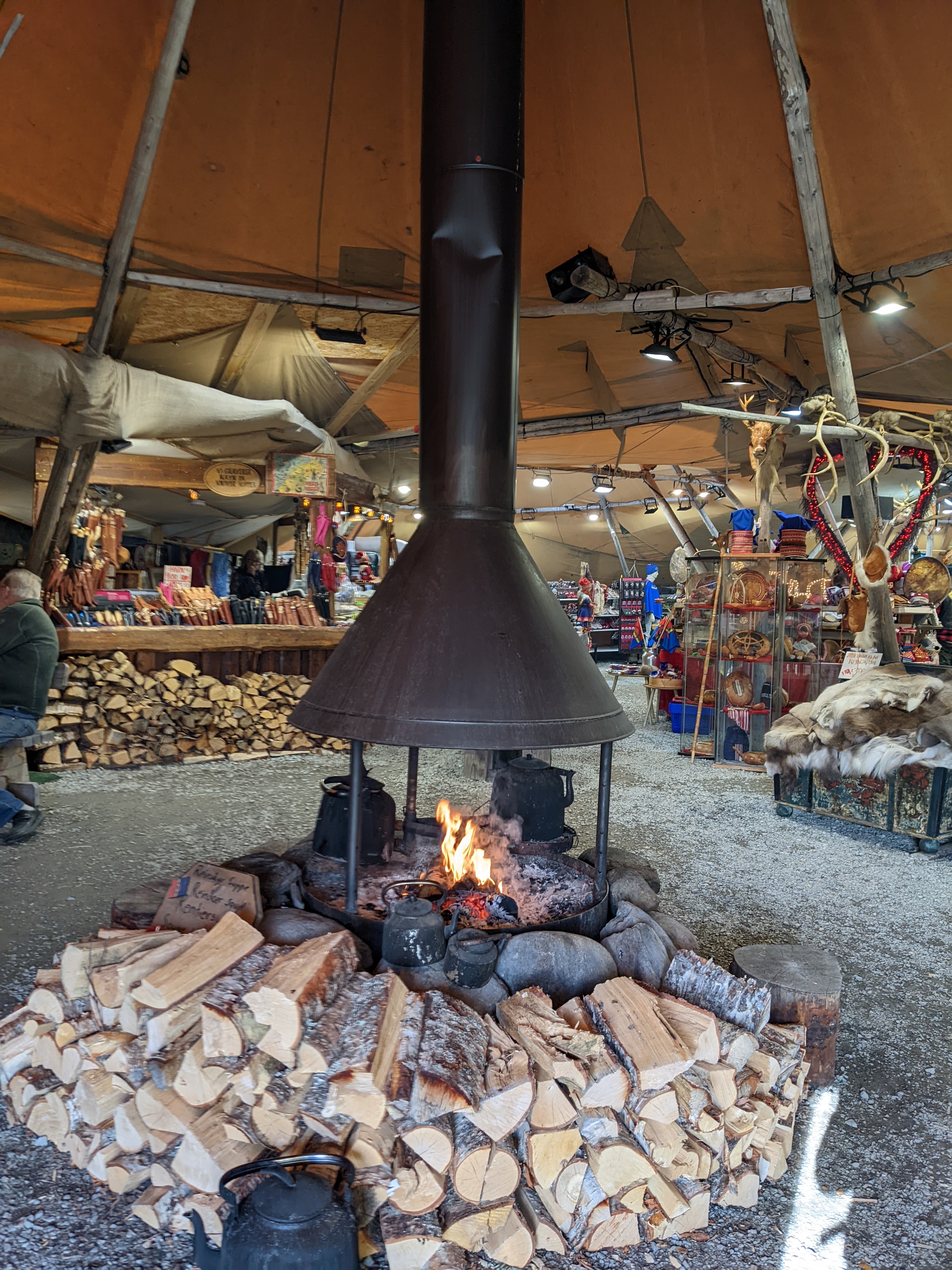
There are reindeer antlers and hides by the barrel-full. Handmade mugs and bowls and knives and drums, some with ash-dyed pattern-etched bone inlays. Reindeer jerkies and sausage, and a freezer of frozen meat if I remember correctly. There are sweaters, of course, because this is Norway, but also simpler-patterned felt ponchos that look so warm and cozy. Traditional headwear, art, and on and on. And hot coffee, for the fifty or so motorcycles parked out front. This is a rest stop, after all.

We passed Takavatnet just a half-kilometer later. The lake was in the late stages of thaw, and some of the remaining ice had melted into funny little spires or cubes. The shapes were too small to see from our vantage, but whenever the wind blew, they all clinked together like the small songs of faraway birds.

We made camp a little farther along, in a thin birch grove fronting some pine woods. There were other conifers mixed in here - fir or spruce, I forget - an unusual bit of variety this early in the trip.
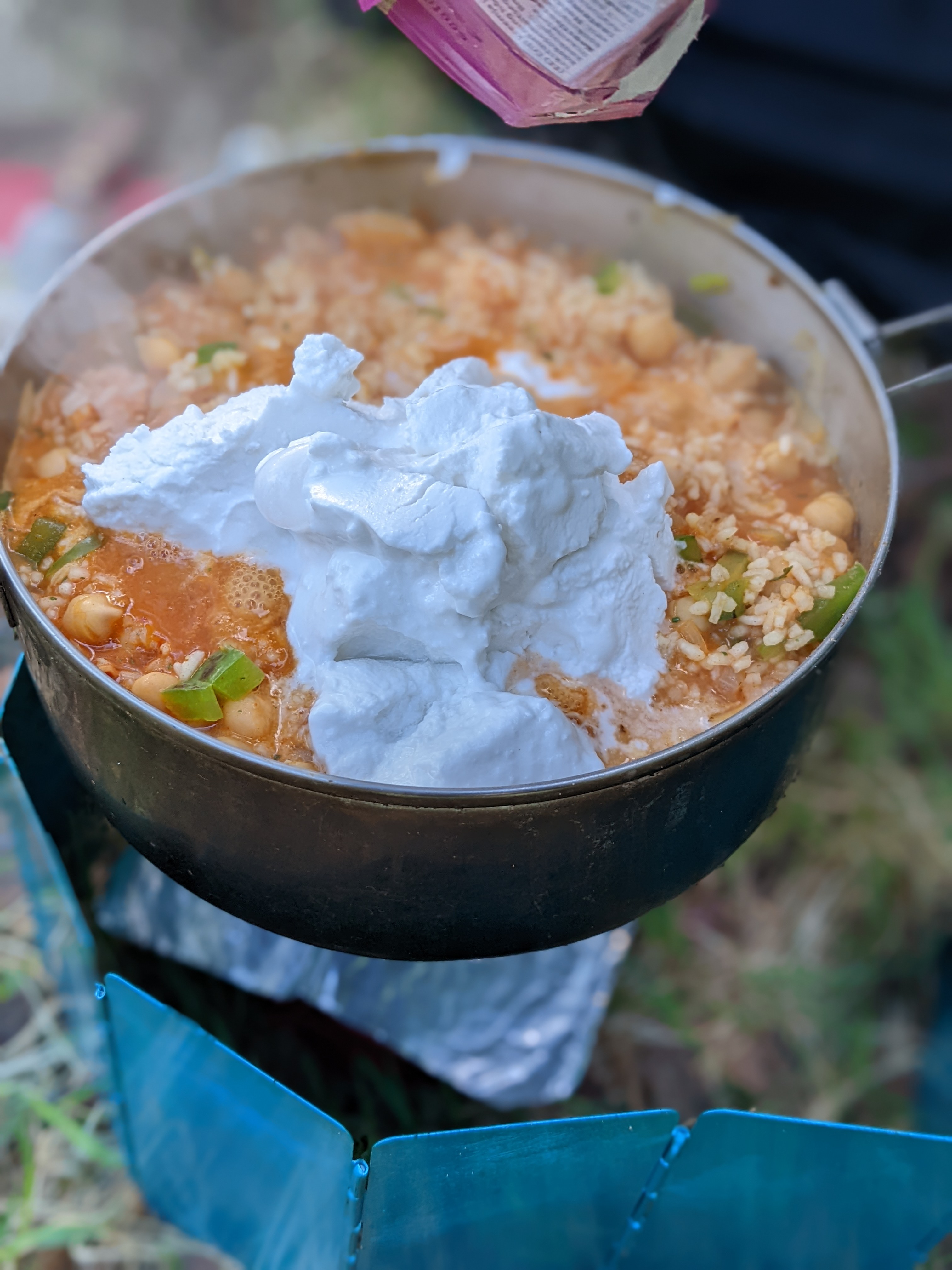
We ate some kind of chickpeas and rice one-pot spice mix thing. These spice mixes are, universally, somewhat forgettable, but when you need a little flavor for your 750 mls of carbs and protein they do just fine. More interesting is the fact that we’ve moved on from coconut milk. It’s too big, and doesn’t pack enough punch, so it’s a full carton of coconut cream in the pot when we can find it. Exercise is amazing.

Spring is still blowing up all around us, and it’s lovely.
The last miles to Dividalen
We started the day with a swoopy little roll downhill, past some lovely homes and a military installation, to the road that leads into Øvre Dividal Nasjonalpark.

We passed the very old Overbydghytta along the way, and then slid from paved road onto beautiful, smooth-tracked gravel.

This track follows the river, up the valley toward the park. Near a steep hill, we passed this beautiful newly constructed hut, built in a very old and traditional style. It’s roofed with turf, and very reminiscent of the buildings we saw at the history museum in Oslo.
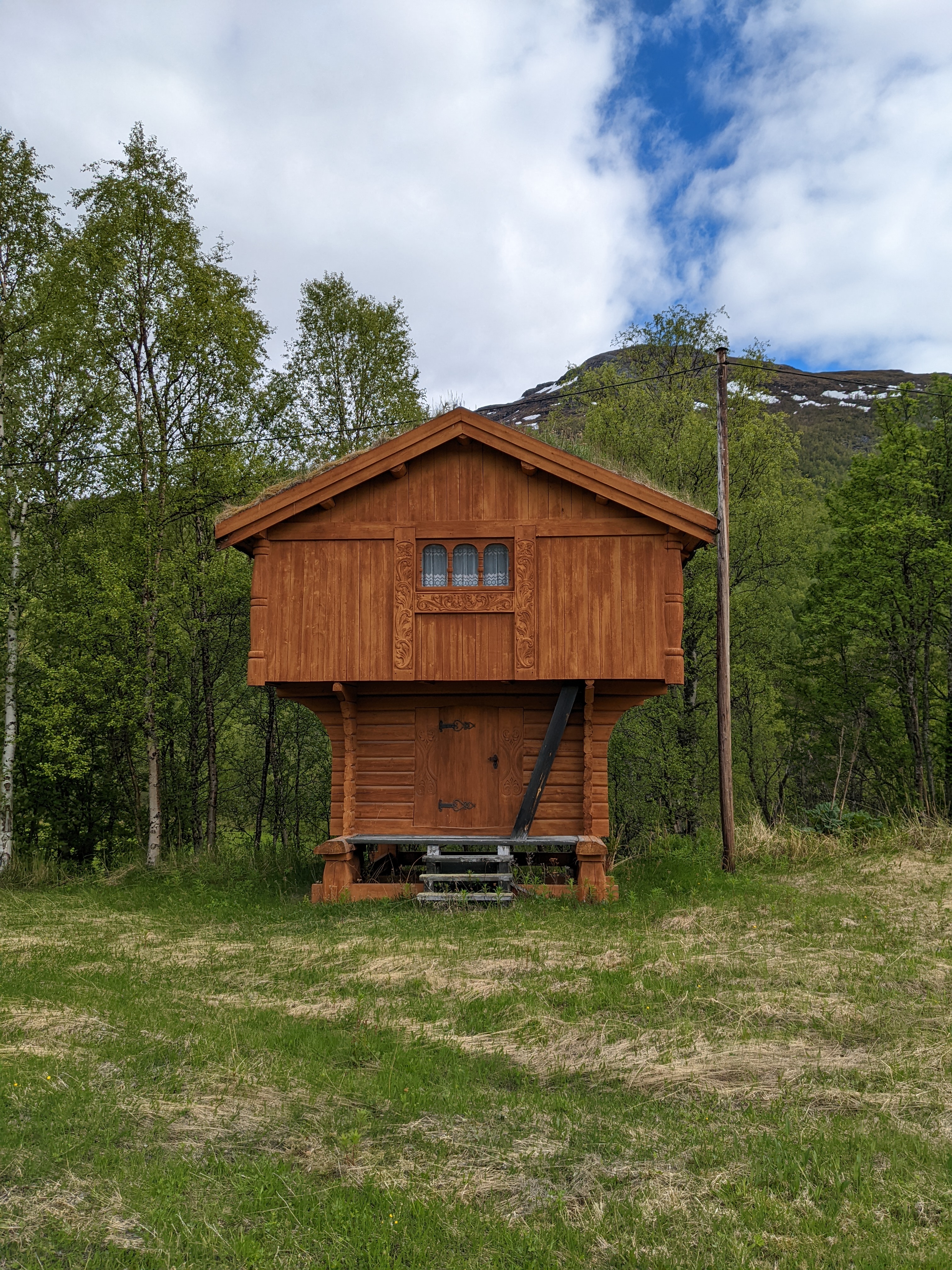
We stopped for lunch at a fishing spot developed for the handicapped, with a paved walk along the river front and easy access from the gravel road. It was neat to see that kind of care put into access. It was even cooler, though, to find an abandoned nest there.

Simple and unused, they are beautifully made from long grass leaves. I suspect these are early stages of some bird’s nesting process, but please correct me if I’m wrong.
New friends
- nest-guys
- legit invertebrate life
- lefse!
- Varieties of tree/shrub we don’t know, which are in full flower here near Øvre Dividal

